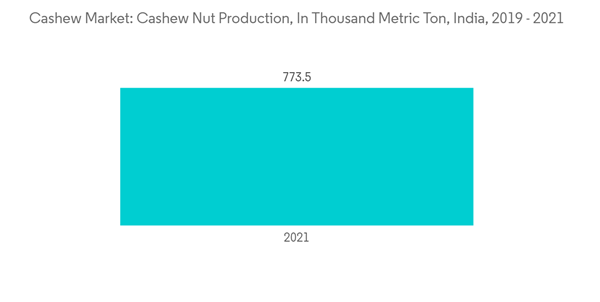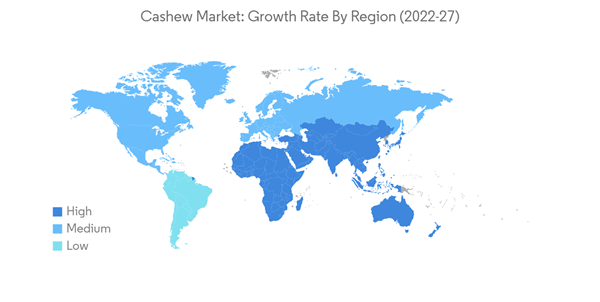Key Highlights
- In recent years, there has been a global trend that looks favorably at vegan and plant-based diets. People who embrace a plant-based vegan diet prioritize alternative sources of protein instead of those derived from animals, resulting in the soaring demand for nuts and nut-infused foods. An increasing number of cashew-infused product manufacturers have attracted young and old consumers with the launch of new and innovative products, such as cashew-butter yogurt in the United States and roasted spice-coated cashew kernels in India. However, the application of cashew kernels in consumers' diets has been steady in South America, with multinational manufacturers penetrating the market with assorted cashew products, suiting the healthier diet regime across the country. Brazil, on the other hand, has always been a price-sensitive consumer of cashew kernels. The resurgence in the Brazilian economy has been troubled by the mounting fiscal deficit, and thus, it is leading the consumption of cashews to depend heavily on the inflation rates.
- Increasing demand for flavored cashews and favorable government initiatives are further fueling the consumption of cashew nuts in the African region. The consumption of cashew kernels, whole or pieces, has had limited exposition to the consumers in West and East Africa, which is attributed to the untapped retail market for ready-to-eat cashews for the consumers in the region. However, the Competitive Cashew Initiative, formerly known as the African Cashew Initiative, has been playing a vital role in the marketing of high-quality raw cashew kernels in Benin, Côte d'Ivoire, Mozambique, and Ghana, which further enhanced the production and processing efficiencies in these countries in various ways, such as the promotion of SAP software in the cashew value chain in West Ghana.
Cashew Market Trends
Rising Consumption of Cashew as a Healthy Snack
- Edible cashews have been used as a snack for a long time. Cashews are also used as one of the main ingredients in preparing various sweet and savory dishes, especially in Asian cuisine. Moreover, cashews are used in mueslis, energy bars, cookies, chocolates, and ice creams. Cashews are known to be high in nutrients, such as copper, which improve bone health, as one ounce of cashew contains 622 micrograms of copper. Nevertheless, cashews have an inflation-driven consumption pattern, as reported by the International Nut and Dried Fruit Council.
- Cashews are relatively high in fiber compared to peanuts, and they help gain a healthy weight by improving digestive function. Such high-value nutrition has prompted snack manufacturers to launch several cashew-based snacks to meet the demand, such as ready-to-drink cashew milk, which acts as a lactose-free milk substitute. Due to increasing health consciousness among consumers in the European region, there has been a growing trend of cashew nut consumption, making the region one of the leading consumers in the world.
- To meet the rising global demand for cashew nuts, many countries have increased their production capacities across the world. According to National Horticulture Board, in India, Cashew production has increased from 0.70 million metric tons in 2020 to 0.77 million metric tons in 2021. Therefore, the increased consumption of cashew nuts as a healthy snack and rising production are anticipated to drive the cashew market in the coming years.
Asia-Pacific Dominates the Market
- Asia-Pacific has been a consistent importer of cashew kernels despite the presence of large cashew-producing countries, such as India and Vietnam, in the region. In terms of consumption, India is the leading country in the world. As Vietnam leads in the production of cashews worldwide, it is also a significant exporter of the same to other international markets.
- Asia-Pacific is the largest consumer of cashew nuts in the world. In recent years, there has been an increasing interest in the use of cashew nuts in regular diets and healthy ready-to-eat snacks. The rising number of manufacturers producing innovative cashew-based consumables has taken both young and geriatric consumers by stride. For example, roasted and spice-coated cashew nuts that appeal to the local palate were introduced in India.
- The demand for cashews in Asia has persistently increased as the imports for shelled cashews increased exponentially by over 700% from 4,321 metric tons in 2017 to 30,688 metric tons in 2021 in China, with Vietnam being the major import partner according to the ITC trade map. China leads the region in cashew import, followed by Japan, Thailand, and India, respectively.
- Nuts have become a primary component in the Chinese diet since the inception of the National Health Policy called 'Dietary Guidelines for Chinese Residents,' which emphasizes daily nut consumption. The increased cashew nut imports may also be attributed to the new product campaign of selling 'daily nuts,' including cashews, in ready-to-eat packages, by Chinese nut manufacturers, thus driving the cashew nut market in the country.
Cashew Industry Overview
Additional Benefits:
- The market estimate (ME) sheet in Excel format
- 3 months of analyst support
This product will be delivered within 2 business days.










